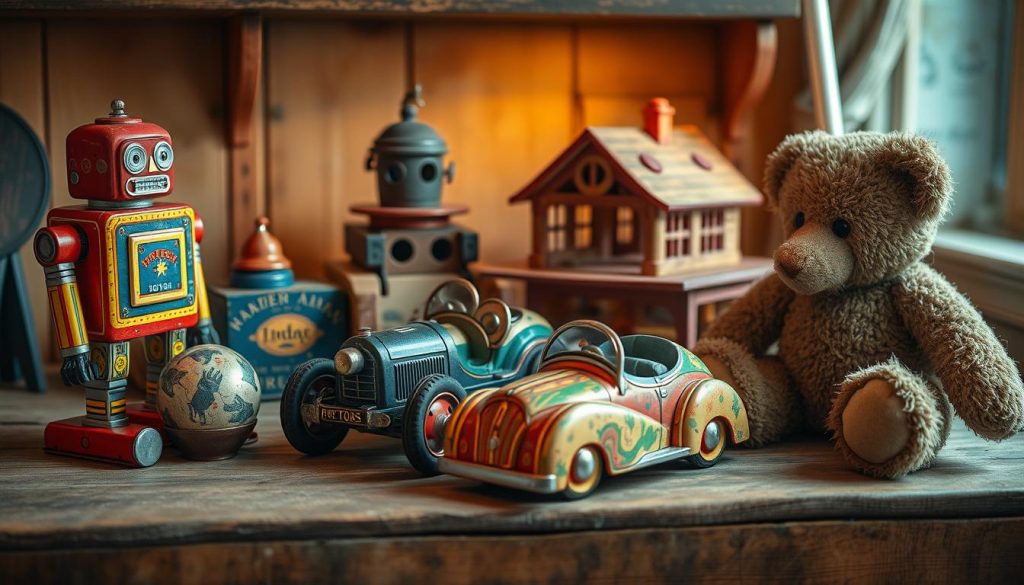The magic of vintage toys isn’t just about how old they are. It’s about their history, rarity, and the strong feelings they bring to collectors. These toys, once meant for play, are now highly valued treasures in the antique toy world. For those who collect them, vintage toys are more than memories. They are windows to our history and precious cultural pieces.
Vintage toys are a big deal in today’s market, fetching high prices. Their rarity as limited-edition items makes them hard to find, which adds to their value. The deep memories they awaken add another layer of value, making them more than just toys. They are treasures and possible investments for those who collect them.
Key Takeaways
- Vintage toys have historical significance and are sought after for their rarity.
- They evoke strong personal connections due to childhood memories.
- The antique toy market has grown, with many considering vintage toys as investments.
- Scarcity and historical value contribute to high market prices.
- These toys are viewed as important cultural artifacts.
The Definition of Vintage Toys
Knowing what ‘vintage’ means in toys is essential for collectors. These toys are usually over 20 to 25 years old. This sets them apart from new collectibles. Vintage toys show the unique features of the time they were made. They carry history, culture, and the tech know-how of their era.
What Qualifies as a Vintage Toy?
To be called vintage, a toy must meet certain criteria. Age is key, with toys from the early to late 20th century often making the cut. These toys display the historical and cultural background of those times. Another point is their make; vintage toys were often crafted from wood, metal, or early plastics. This was before more modern materials became popular.
How Vintage Toys Differ from Collectibles
Vintage toys and collectibles are both prized by fans. Yet, they are not the same. Vintage toys must be old enough to show traits of their era. Collectibles might be newer but still hold great value. This value can come from being rare or linked to famous brands. Figuring out if a toy is vintage requires attention to detail. One must look at how it’s made, its brand, and its package.
Understanding the history and identification of vintage toys aids collectors. It helps ensure their collections are true and of worth.
A Brief History of Vintage Toys
Vintage toys have changed a lot from early wooden items to plastic. These changes show how technology and culture evolved. They remind us of the past and show the importance of key times and brands in toy history.
Key Eras in Toy History
Toy history has several important periods:
- Early Wooden Toys: These started as simple wooden figures. They show the skill of early toy makers.
- Tin Toys Era: In the late 1800s and early 1900s, tin toys were popular for their lasting quality and detailed designs.
- Post-War Boom: After World War II, toy making boomed. New materials like plastic changed the industry and made toys easier to get.
- Rise of Licensed Merchandise: In the later 20th century, toys based on TV and movie characters became big. This includes Star Wars and Disney toys.
Influential Toy Brands and Manufacturers
Some companies have made a big impact on the toy world. Brands like Hasbro, Mattel, and LEGO are known for their quality and new ideas. Their work has made many kids happy and changed how toys are made and collected.
- Hasbro: It’s famous for G.I. Joe and Transformers. Hasbro is a leader in the toy industry.
- Mattel: Mattel made Barbie and Hot Wheels. They’ve been leaders in creating toys that spark imagination.
- LEGO: Known for its bricks that connect, LEGO is famous for inspiring creativity and building skills.
This trip through toy history and learning about key brands shows why vintage toys and their stories matter. People who collect toys value them not just for the memories but also for their link to history and innovation.
The Factors That Determine Value
Understanding the factors that influence vintage toy values is crucial in appraisal. Certain elements make some toys more desirable than others. This causes their values to vary.
Rarity and Demand
Rarity and demand play a big role in a toy’s value. If a toy was made in small amounts or stopped being made, its rarity increases. This makes it very valuable over time.
High demand for these toys can push their value even higher. This is especially true if the toys are hard to find. Toys that are limited editions or from certain time periods are very popular.
Condition and Authenticity
The toy’s condition is also very important. Toys in perfect shape or with original packaging are worth more. Collectors value toys more if they are not damaged, missing pieces, or repaired.
Authenticity matters a lot too. Toys with verified maker’s marks, original parts, and documentation are more valuable. This helps prove they are real and increases their worth.
| Factor | Impact on Value |
|---|---|
| Rarity | Increases value due to limited availability |
| Demand | Higher demand raises market prices |
| Condition | Mint condition significantly boosts value |
| Authenticity | Verified marks and original parts enhance value |
Iconic Vintage Toys Worth Collecting
Some toys have become highly valued in collections, standing the test of time. They bring back memories and are worth a lot of money. Let’s look at the classic action figures, board games, and dolls that are important in the world of vintage toys.

Classic Action Figures
G.I. Joe and Star Wars figures are big hits with vintage toy collectors. G.I. Joe started a new era in the 1960s for action figures. Star Wars figures from the 1970s and 1980s are very popular among collectors. Their rarity, condition, and whether they are real or not play a big role in their worth.
Timeless Board Games
Board games like Monopoly and Risk have been loved for many years. They are still valuable collectibles today. Games that are the first edition or have something special about them are sold for a lot of money.
Beloved Childhood Dolls
Dolls, especially Barbies and Madame Alexander, are favorites among collectors. When Barbie was released by Mattel in 1959, it was a big deal in the toy world. This led to many versions that collectors look for. Madame Alexander dolls are also loved for their quality and beautiful outfits.
The Role of Nostalgia in Valuation
Nostalgia greatly affects how much vintage toys are worth. Many collectors love the idea of having a favorite toy from when they were kids. This feeling makes them want to buy these old toys, raising their demand and prices.
Why Nostalgia Drives Prices Up
The way nostalgia makes us feel about vintage toys helps explain their high prices. These toys often remind us of big moments in culture or personal achievements. When they come back on the market, grown-up collectors are ready to spend more to bring back a part of their youth. This makes the toys even more valuable.
Collectors’ Emotional Connections
Collectors feel a deep connection to vintage toys that goes beyond nostalgia. They see owning these items as having a piece of history. This emotional bond raises the item’s value more than what it looks like. The market for vintage toys does well because collectors enjoy the search. They want to feel the happiness and innocence of their childhood again.
Market Trends for Vintage Toys
The demand for vintage toys has risen sharply in recent years. This boost in the antique toy market comes from easy online access, offering collectors a bigger playground. As a result, the prices for rare collectibles have gone up.
The Rise in Popularity of Vintage Collectibles
Nostalgia is a huge factor driving the popularity of vintage collectibles. Many people buy these toys to relive their childhoods. Flipping, or buying toys cheap to sell at a higher price, has also invigorated the market. This trend has attracted newcomers looking for bargains to turn a profit.
The increasing popularity of vintage toys has led collectors to explore different eras and types of toys, from classic action figures to timeless board games, creating a diverse and ever-evolving market.
How Digital Platforms Influence Prices
Digital platforms have changed the game in the antique toy market. They let collectors connect, trade, and share advice easily. Because of online bidding, prices for in-demand toys have soared. The global market access online means collectors aren’t limited by location, pushing prices even higher.
| Platform | Impact on Prices | Influence on the Market |
|---|---|---|
| eBay | High due to global bidding | Wider market reach, higher selling prices |
| Social Media (e.g., Facebook Marketplace, Instagram) | Moderate to High | Increased awareness, community-driven sales |
| Specialty Collector Sites | Variable | Focused audiences, niche markets |
Tips for Collectors
Collecting vintage toys is fun and rewarding. But, you need to pay attention to details and take good care of them. Here are some key tips for finding valuable toys and keeping them in great shape.
How to Spot Valuable Vintage Toys
Looking for valuable vintage toys? Start by checking for manufacturing errors or limited editions. These can make a toy much more valuable. Also, having the original box in good shape helps. Look for toys from well-known brands like Mattel, Hasbro, and Fisher-Price. A unique serial number or a certificate of authenticity also adds to a toy’s value.
To appraise a vintage toy, find out how old it is, how many were made, and its history. Toys from big names like Star Wars, G.I. Joe, or Barbie are usually worth more, especially the older ones. Use trusted guides or talk to an expert if you’re not sure about a toy’s value.
Best Practices for Care and Preservation
It’s important to keep your vintage toys in good condition to maintain their value. Proper care includes good storage, cleaning, and sometimes fixing them up.
- Storage: Store toys somewhere dry and with controlled temperature to avoid heat or humidity damage. Use acid-free boxes or display cases that protect against light.
- Cleaning: Gently clean toys with a soft cloth and mild soap that’s pH-neutral. Stay away from harsh chemicals or rough cleaning tools.
- Repair: Fix minor issues with proper materials that won’t hurt the toy’s original state. For big fixes, go to pros who know how to handle vintage toys.
Keep a detailed record of your collection, including photos and descriptions. This helps with appraising and managing your toys. It’s also useful if you ever want to sell or insure them.
Where to Buy and Sell Vintage Toys
Finding the right place to trade vintage toys impacts your buying and selling journey. Options abound, catering to online convenience or the joy of in-person browsing. Understanding where to look helps collectors find unique pieces of history.
Online Marketplaces and Auctions
Online marketplaces and auctions have become key for collectors. Websites like eBay, Etsy, and Ruby Lane showcase a wide variety of vintage toys. Buyers and sellers can check ratings and reviews, ensuring trustworthy transactions. Online auctions offer rare finds at good prices, but it’s important to avoid overspending by sticking to a budget.
Local Shops and Estate Sales
For hands-on collectors, local shops, antique stores, and flea markets are ideal. They let you check an item’s condition firsthand and meet experts. Estate sales can be goldmines for unique toys at affordable prices. Use local listings and social media to find these opportunities effortlessly.
Choosing between online or in-person shopping requires careful research. Verify item authenticity and seller credibility. Avoid deals that seem suspicious. With diligence and the right sources, collectors can thrive in the vintage toy market.

